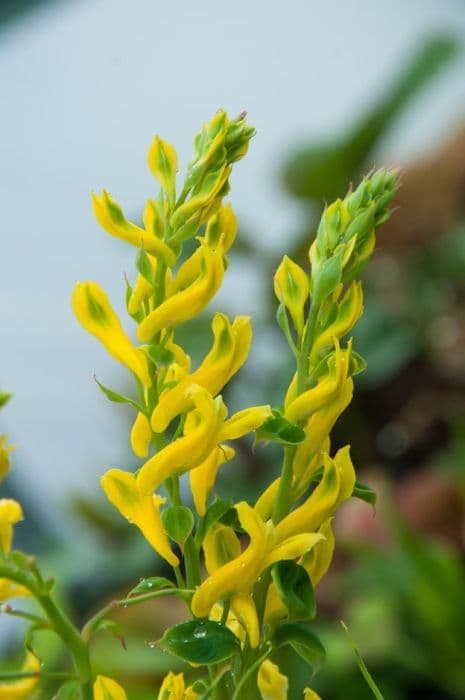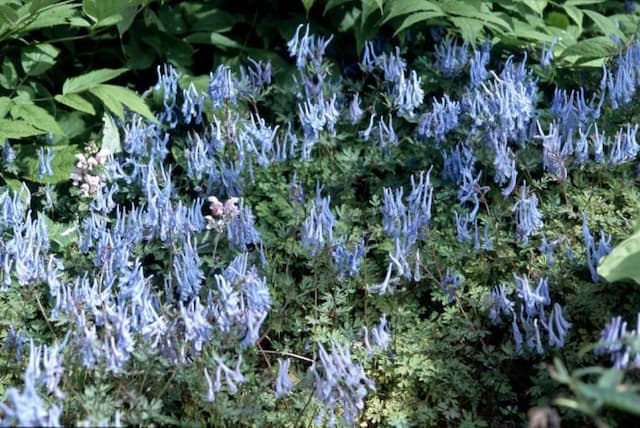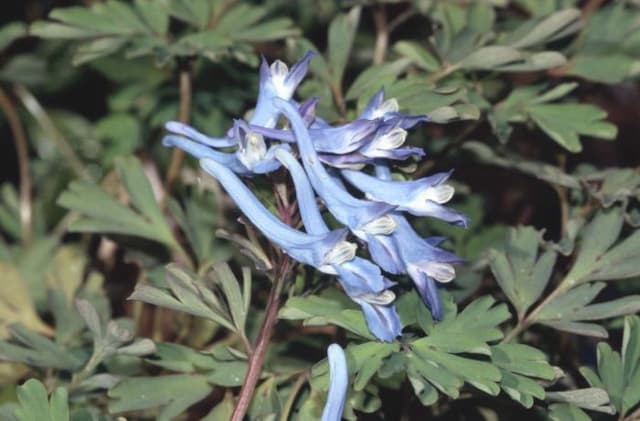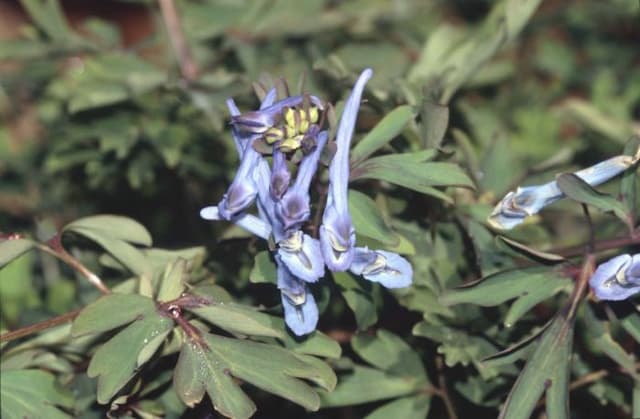Fumewort Corydalis solida 'Firecracker'

ABOUT
The Corydalis solida 'Firecracker' is a striking plant known for its vibrant and colorful appeal. This plant features delicate, fern-like, blue-green foliage that provides a perfect backdrop for its standout feature, the flowers. The blossoms are tubular with a slightly curved spur, displaying a rich, purplish-pink hue that gives the plant its firecracker name, as it seems to burst with color in the landscape. The flowers are neatly arranged in dense clusters atop slender stalks, creating an attractive display that can catch the eye from a distance. The blooming period of 'Firecracker' occurs in the early spring, providing a much-needed splash of color after the winter season. The effect of the contrasting foliage and the vivid flowers makes this plant a favorite among gardeners looking to add some dramatic flair to their gardens. Despite its striking appearance, the plant maintains a modest and neat presentation, making it suitable for a variety of garden settings.
About this plant
 Names
NamesFamily
Papaveraceae
Synonyms
Fumewort
Common names
Corydalis solida 'Firecracker'.
 Toxicity
ToxicityTo humans
The plant known as Fumewort is not commonly listed as toxic to humans. However, most plants have the potential to cause allergic reactions or discomfort if ingested in large quantities. In general, it is advisable to avoid eating ornamental plants due to the possible presence of unknown toxic compounds. If Fumewort is consumed, symptoms may vary and could include gastrointestinal upset, but reported cases are rare, and specific toxic effects to humans are not well-documented. Seeking medical advice is recommended if ingestion occurs or if symptoms appear.
To pets
Fumewort is not widely reported to be toxic to pets. Nonetheless, it is typically advised to prevent pets from eating ornamental plants, as they could contain compounds that might cause reactions or be harmful in other ways not fully understood. If a pet ingests Fumewort, it is possible that they might experience mild gastrointestinal discomfort or an allergic reaction, although such cases are not commonly reported. If you suspect your pet has consumed any part of the plant and is showing signs of illness, it is important to consult with a veterinarian.
 Characteristics
CharacteristicsLife cycle
Perennials
Foliage type
Deciduous
Color of leaves
Green
Flower color
Purple
Height
10 inches (25 cm)
Spread
6 inches (15 cm)
Plant type
Bulb
Hardiness zones
5
Native area
Europe
Benefits
 General Benefits
General Benefits- Ornamental Appeal: Corydalis 'Firecracker' has vibrant, deep purple flowers that add a splash of color to the garden in early spring.
- Easy to Grow: This plant is relatively low-maintenance, requiring minimal care once established in the right conditions.
- Shade Tolerance: It thrives in partial to full shade, making it a great choice for woodland gardens and other shaded areas.
- Naturalizing: 'Firecracker' can spread over time, forming attractive clumps that naturalize well, especially in a woodland setting.
- Pest Resistance: It is generally resistant to pests and diseases, reducing the need for chemical interventions.
- Attracts Pollinators: The flowers of the Corydalis 'Firecracker' attract bees and other pollinators, supporting local ecosystems.
- Spring Bloom: It offers an early source of blooms in the garden, often flowering from late winter to early spring when few other plants are in bloom.
- Drought Tolerance: Once established, Corydalis 'Firecracker' can tolerate periods of drought, although it prefers moist soils.
- Companion Planting: Its compact growth habit makes it a good companion for other shade-loving perennials, such as hostas and ferns.
- Deer Resistance: Corydalis 'Firecracker' is not a favorite of deer, making it a good choice for gardens in areas with a high deer population.
 Medical Properties
Medical Properties- Analgesic properties: Corydalis solida may contain compounds that can act as pain relievers.
- Sedative effects: Some Corydalis species have been used traditionally to help with sleep and reduce anxiety.
 Air-purifying Qualities
Air-purifying QualitiesThis plant is not specifically known for air purifying qualities.
 Other Uses
Other Uses- The tubers of Corydalis solida can be used to produce natural dyes, for coloring textiles with shades of yellow to golden brown.
- Floral arrangements often benefit from the addition of Corydalis solida blooms, offering a touch of vivid color to mixed bouquets.
- In a wildlife garden, Corydalis solida can provide an early source of nectar for bees and other pollinating insects emerging in the spring.
- Used in education, the plant can help in teaching botanical concepts like bulb growth cycles and spring ephemerals in gardening courses or workshops.
- The plant may be used in landscape photography, adding a burst of color to garden scenes or natural landscapes during the early spring.
- Culinary experimentation with the flowers can lead to their use as a non-traditional garnish for desserts, although caution should be exercised as not all parts are edible.
- Artists may use dried Corydalis solida flowers for crafting, such as in potpourri blends or for decorative purposes in homemade papermaking.
- The unusual coloration of Corydalis solida 'Firecracker', with its deep purplish-red hues, can inspire artwork, fabric designs, or be used in color therapy sessions.
- In contemporary planting design, Corydalis solida can be used as a living marker to indicate where other perennials will emerge later in the season.
- Children’s gardens can use Corydalis solida to introduce youngsters to the wonders of nature, with its bright colors helping to spark their interest in the plant world.
Interesting Facts
 Feng Shui
Feng ShuiThe plant Fumewort is not used in Feng Shui practice.
 Zodiac Sign Compitability
Zodiac Sign CompitabilityThe plant Fumewort is not used in astrology practice.
 Plant Symbolism
Plant Symbolism- Hope: Corydalis, in general, have been used to symbolize hope due to their ability to emerge early in spring and push through the last bits of snow.
- Resilience: The 'Firecracker' variety, with its robust color and growth in adverse conditions, represents resilience and the ability to thrive despite challenges.
- Transcendence: Its delicate appearance yet strong nature can symbolize transcending above troubles or challenges in life.
- Joy and Celebration: The bright color of 'Firecracker' is often associated with joy, celebration, and the vibrancy of life.
 Water
WaterFumewort should be watered deeply enough to soak the soil surrounding the roots, typically requiring about 1 gallon per week during its growing season in spring. Ensure that the soil is well-draining and does not remain waterlogged to prevent root rot. Water early in the morning to allow foliage to dry out during the day, reducing the risk of fungal diseases. During the dormant period in summer, after the foliage dies back, reduce watering significantly and resume regular watering when the plant re-emerges in the next growing season.
 Light
LightFumewort thrives in light conditions ranging from partial shade to full shade. It is best to place it in a spot where it can receive filtered sunlight or morning sun followed by afternoon shade. Avoid exposing fumewort to the intense, direct sun which can scorch its delicate leaves and flowers.
 Temperature
TemperatureFumewort prefers temperate climates and does well in a temperature range of 50 to 75 degrees Fahrenheit. It can tolerate a minimum temperature down to about 20 degrees Fahrenheit but should be protected from severe winter cold. The ideal temperature for optimal growth of fumewort is typically around 60 to 65 degrees Fahrenheit.
 Pruning
PruningFumewort does not typically require pruning; you should only remove spent flower stems after flowering to encourage a tidy appearance and potential reblooming. If desired, after the foliage naturally dies back at the beginning of the plant's summer dormancy, you can trim away dead leaves. The best time for any cleanup is after flowering and before the summer dormant period.
 Cleaning
CleaningAs needed
 Soil
SoilFumewort (Corydalis solida 'Firecracker') thrives in a soil mix that is rich in organic matter, moist, and well-draining with a slight preference for acidity to neutral pH, ranging from 6.0 to 7.0. A blend of loamy garden soil, compost, and leaf mold or peat moss is ideal, ensuring the soil retains moisture while also allowing excess water to drain away to prevent root rot.
 Repotting
RepottingFumewort should be repotted every 2-3 years or when it becomes root-bound. It's best repotted after flowering when the plant enters dormancy. Gently divide the tubers if necessary to propagate or to refresh the growing medium.
 Humidity & Misting
Humidity & MistingFumewort prefers a moderately humid environment, which mimics its natural woodland habitat. It does not require high humidity and will typically be content with the average humidity levels found in most homes.
 Suitable locations
Suitable locationsIndoor
Place Fumewort in bright, indirect light and cool temperatures.
Outdoor
Plant Fumewort in partial shade and well-drained soil.
Hardiness zone
5-7 USDA
 Life cycle
Life cycleCorydalis solida 'Firecracker', also known as Fumewort 'Firecracker', commences its life cycle as a tuber, which remains dormant underground during the summer. In late winter to early spring, it breaks dormancy by sprouting feathery foliage and striking, deep purple blooms that attract early pollinators. After flowering, the plant sets seed through self-pollination or with the assistance of visiting insects. By late spring, the foliage yellows and withers, signaling the end of the plant's above-ground growth for the season. The seeds fall to the ground, potentially germinating to produce new plants, while the mother tuber re-enters dormancy. Throughout autumn and winter, the plant remains underground until the cycle recommences with the next warming cycle.
 Propogation
PropogationPropogation time
Late summer to early autumn
Propogation: The Corydalis 'Firecracker', also known as Fumewort, is most commonly propagated by dividing its tubers. The optimal time for this process is in late summer to early fall, after the plant has finished flowering and the foliage has died back. To propagate 'Firecracker', carefully dig up the clump of tubers, making sure to do so gently to avoid damage. The tubers can then be gently pulled apart, ensuring that each division has at least one growth point or eye. These divisions should be replanted at a depth of about 2 inches (approximately 5 centimeters) in well-drained soil, maintaining an appropriate distance between each to allow for adequate growth. The newly planted tubers should be watered well to establish them. This method of division helps to not only propagate new plants but also to invigorate older clumps that may have become too dense over time.









